Previous issues
- Page Path
- HOME > Browse Articles > Previous issues
- [Korean]
- Investigation on the Thermoelectric Properties of Bismuth Telluride Matrix Composites by Addition of Graphene Oxide Powders
- Kyung Tae Kim, Taesik Min, Dong Won Kim
- J Korean Powder Metall Inst. 2016;23(4):263-269. Published online August 1, 2016
- DOI: https://doi.org/10.4150/KPMI.2016.23.4.263
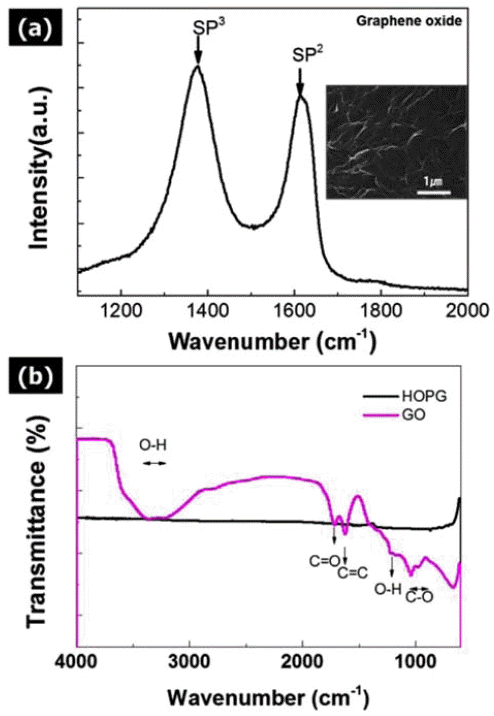
- 626 View
- 1 Download
- 6 Citations
-
 Abstract
Abstract
 PDF
PDF Graphene oxide (GO) powder processed by Hummer's method is mixed with p-type Bi2Te3 based thermoelectric materials by a high-energy ball milling process. The synthesized GO-dispersed p-type Bi2Te3 composite powder has a composition of Bi0.5Sb1.5Te3 (BSbT), and the powder is consolidated into composites with different contents of GO powder by using the spark plasma sintering (SPS) process. It is found that the addition of GO powder significantly decreases the thermal conductivity of the pure BSbT material through active phonon scattering at the newly formed interfaces. In addition, the electrical properties of the GO/BSbT composites are degraded by the addition of GO powder except in the case of the 0.1 wt% GO/BSbT composite. It is found that defects on the surface of GO powder hinder the electrical transport properties. As a result, the maximum thermoelectric performance (ZT value of 0.91) is achieved from the 0.1% GO/BSbT composite at 398 K. These results indicate that introducing GO powder into thermoelectric materials is a promising method to achieve enhanced thermoelectric performance due to the reduction in thermal conductivity.
-
Citations
Citations to this article as recorded by- Nanocomposite Strategy toward Enhanced Thermoelectric Performance in Bismuth Telluride
Hua‐Lu Zhuang, Jincheng Yu, Jing‐Feng Li
Small Science.2025;[Epub] CrossRef - Exploring Thermoelectric Transport Properties and Band Parameters of n-Type Bi2-xSbxTe3 Compounds Using the Single Parabolic Band Model
Linh Ba Vu, Soo-ho Jung, Jinhee Bae, Jong Min Park, Kyung Tae Kim, Injoon Son, Seungki Jo
journal of Korean Powder Metallurgy Institute.2024; 31(2): 119. CrossRef - Enhancing Electrical Properties of N-type Bismuth Telluride Alloys through Graphene Oxide Incorporation in Extrusion 3D Printing
Jinhee Bae, Seungki Jo, Kyung Tae Kim
journal of Korean Powder Metallurgy Institute.2023; 30(4): 318. CrossRef - Advancement of thermoelectric performances through the dispersion of expanded graphene on p-type BiSbTe alloys
Eun-Ha Go, Rathinam Vasudevan, Babu Madavali, Peyala Dharmaiah, Min-Woo Shin, Sung Ho Song, Soon-Jik Hong
Powder Metallurgy.2023; 66(5): 722. CrossRef - The role of edge-oxidized graphene to improve the thermopower of p-type bismuth telluride-based thick films
Young Min Cho, Kyung Tae Kim, Gi Seung Lee, Soo Hyung Kim
Applied Surface Science.2019; 476: 533. CrossRef - The Preparation and Growth Mechanism of the Recovered Bi2Te3 Particles with Respect to Surfactants
Hyeongsub So, Eunpil Song, Yong-Ho Choa, Kun-Jae Lee
Journal of Korean Powder Metallurgy Institute.2017; 24(2): 141. CrossRef
- Nanocomposite Strategy toward Enhanced Thermoelectric Performance in Bismuth Telluride
- [Korean]
- Morphology Control of ZnO Nanostructures by Surfactants During Hydrothermal Growth
- Il-Kyu Park
- J Korean Powder Metall Inst. 2016;23(4):270-275. Published online August 1, 2016
- DOI: https://doi.org/10.4150/KPMI.2016.23.4.270
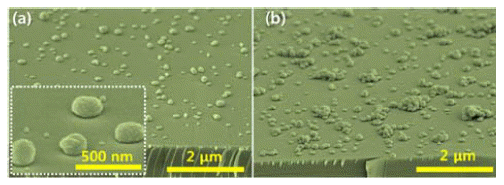
- 699 View
- 1 Download
- 1 Citations
-
 Abstract
Abstract
 PDF
PDF We report on an all-solution-processed hydrothermal method to control the morphology of ZnO nanostructures on Si substrates from three-dimensional hemispherical structures to two-dimensional thin film layers, by controlling the seed layer and the molar contents of surfactants during their primary growth. The size and the density of the seed layer, which is composed of ZnO nanodots, change with variation in the solute concentration. The ZnO nanodots act as heterogeneous nucleation sites for the main ZnO nanostructures. When the seed layer concentration is increased, the ZnO nanostructures change from a hemispherical shape to a thin film structure, formed by densely packed ZnO hemispheres. In addition, the morphology of the ZnO layer is systematically controlled by using trisodium citrate, which acts as a surfactant to enhance the lateral growth of ZnO crystals rather than a preferential one-dimensional growth along the c-direction. X-ray diffraction and energy dispersive X-ray spectroscopy results reveal that the ZnO structure is wurtzite and did not incorporate any impurities from the surfactants used in this study.
-
Citations
Citations to this article as recorded by- La-doped p-type ZnO nanowire with enhanced piezoelectric performance for flexible nanogenerators
Leeseung Kang, HyeLan An, Ji Young Park, Myung Hwan Hong, Sahn Nahm, Chan Gi Lee
Applied Surface Science.2019; 475: 969. CrossRef
- La-doped p-type ZnO nanowire with enhanced piezoelectric performance for flexible nanogenerators
- [English]
- Synthesis of Carbonyl Iron-reinforced Polystyrene by High Energy Ball Milling
- Hong-Hai Nguyen, Minh-Thuyet Nguyen, Won Joo Kim, Jin-Chun Kim, Young-Soo Kim, Young-Hyuk Kim, Olga B. Nazarenko
- J Korean Powder Metall Inst. 2016;23(4):276-281. Published online August 1, 2016
- DOI: https://doi.org/10.4150/KPMI.2016.23.4.276
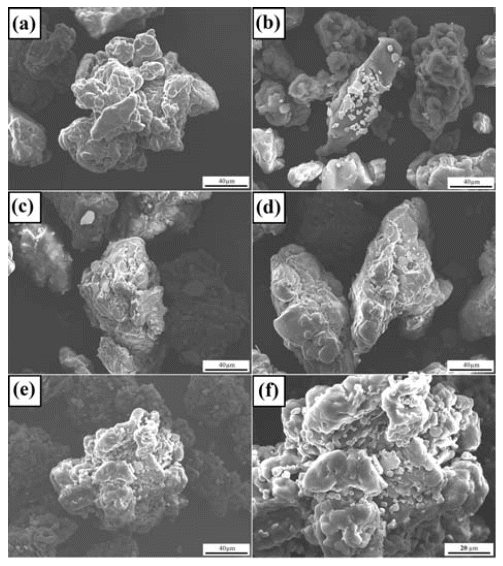
- 873 View
- 5 Download
- 1 Citations
-
 Abstract
Abstract
 PDF
PDF Carbonyl iron (CI) is successfully incorporated as an additive into a polystyrene (PS) matrix via a highenergy ball milling method, under an n-hexane medium with volume fractions between 1% and 5% for electromagnetic interference shielding applications by the combination of magnetic CI and an insulating PS matrix. The morphology and the dispersion of CI are investigated by field emission scanning electron microscopy, which indicates a uniform distribution of CI in the PS matrix after 2 h of milling. The thermal behavior results indicate no significant degradation of the PS when there is a slight increase in the onset temperature with the addition of CI powder, when compared to the as-received PS pellet. After milling, there are no interactions between the CI and the PS matrix, as confirmed by Fourier transformed infrared spectroscopy. In this study, the milled CI-PS powder is extruded to make filaments, and can have potential applications in the 3-D printing industry.
-
Citations
Citations to this article as recorded by- Progress toward sustainable polymer technologies with ball-mill grinding
Antonio Rizzo, Gregory I. Peterson
Progress in Polymer Science.2024; 159: 101900. CrossRef
- Progress toward sustainable polymer technologies with ball-mill grinding
- [English]
- Fabrication of Sintered Compact of Fe-TiB2 Composites by Pressureless Sintering of (FeB+TiH2) Powder Mixture
- Xuan-Khoa Huynh, Ji Soon Kim
- J Korean Powder Metall Inst. 2016;23(4):282-286. Published online August 1, 2016
- DOI: https://doi.org/10.4150/KPMI.2016.23.4.282
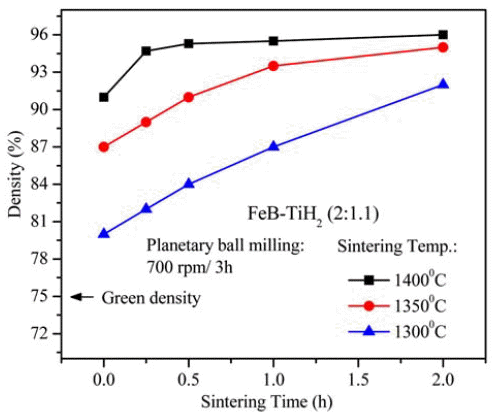
- 713 View
- 1 Download
- 3 Citations
-
 Abstract
Abstract
 PDF
PDF A sintered body of TiB2-reinforced iron matrix composite (Fe-TiB2) is fabricated by pressureless-sintering of a mixture of titanium hydride (TiH2) and iron boride (FeB) powders. The powder mixture is prepared in a planetary ball-mill at 700 rpm for 3 h and then pressurelessly sintered at 1300, 1350 and 1400°C for 0-2 h. The optimal sintering temperature for high densities (above 95% relative density) is between 1350 and 1400°C, where the holding time can be varied from 0.25 to 2 h. A maximum relative density of 96.0% is obtained from the (FeB+TiH2) powder compacts sintered at 1400°C for 2 h. Sintered compacts have two main phases of Fe and TiB2 along with traces of TiB, which seems to be formed through the reaction of TiB2 formed at lower temperatures during the heating stage with the excess Ti that is intentionally added to complete the reaction for TiB2 formation. Nearly fully densified sintered compacts show a homogeneous microstructure composed of fine TiB2 particulates with submicron sizes and an Fe-matrix. A maximum hardness of 71.2 HRC is obtained from the specimen sintered at 1400°C for 0.5 h, which is nearly equivalent to the HRC of conventional WC-Co hardmetals containing 20 wt% Co.
-
Citations
Citations to this article as recorded by- Optimizing the Microstructure and Properties of Fe–Ni–Cu–Mo–C Sintered Steel by TiB2
Zenglin Liu, Yankang Wang, Weilong Lu, Feng Liu, Wei Han, Wuqiang He
Science of Advanced Materials.2024; 16(6): 707. CrossRef - Effect of Ce Addition on the As-Cast and As-Forged Microstructure of Fe-TiB2 Composites
Lin Zhang, Jianwen Gao, Minghao Huang, Engang Wang
JOM.2019; 71(11): 4144. CrossRef - Microstructure, mechanical, and tribological properties of pressureless sintered and spark plasma sintered Fe TiB2 nanocomposites
Hak-Rae Cho, Ji-Soon Kim, Koo-Hyun Chung
Tribology International.2019; 131: 83. CrossRef
- Optimizing the Microstructure and Properties of Fe–Ni–Cu–Mo–C Sintered Steel by TiB2
- [Korean]
- Effects of Precursor Co-Precipitation Temperature on the Properties of LiNi1/3Co1/3Mn1/3O2 Powders
- Woonghee Choi, Chan Hyoung Kang
- J Korean Powder Metall Inst. 2016;23(4):287-296. Published online August 1, 2016
- DOI: https://doi.org/10.4150/KPMI.2016.23.4.287
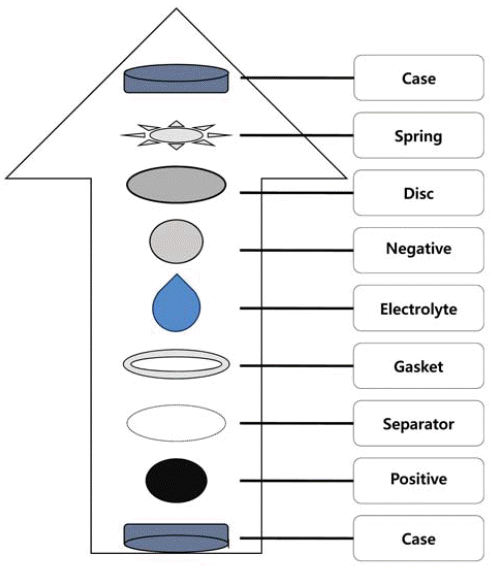
- 1,476 View
- 31 Download
- 1 Citations
-
 Abstract
Abstract
 PDF
PDF Ni1/3Co1/3Mn1/3(OH)2 powders have been synthesized in a continuously stirred tank reactor via a co-precipitation reaction between aqueous metal sulfates and NaOH using NH4OH as a chelating agent. The co-precipitation temperature is varied in the range of 30-80°C. Calcination of the prepared precursors with Li2CO3 for 8 h at 1000°C in air results in Li Ni1/3Co1/3Mn1/3O2 powders. Two kinds of obtained powders have been characterized by X-ray diffraction (XRD), scanning electron microscopy, particle size analyzer, and tap density measurements. The co-precipitation temperature does not differentiate the XRD patterns of precursors as well as their final powders. Precursor powders are spherical and dense, consisting of numerous acicular or flaky primary particles. The precursors obtained at 70 and 80°C possess bigger primary particles having more irregular shapes than those at lower temperatures. This is related to the lower tap density measured for the former. The final powders show a similar tendency in terms of primary particle shape and tap density. Electrochemical characterization shows that the initial charge/discharge capacities and cycle life of final powders from the precursors obtained at 70 and 80°C are inferior to those at 50°C. It is concluded that the optimum co-precipitation temperature is around 50°C.
-
Citations
Citations to this article as recorded by- A kinetic descriptor to optimize Co-precipitation of Nickel-rich cathode precursors for Lithium-ion batteries
Seon Hwa Lee, Ki Young Kwon, Byeong Kil Choi, Hyun Deog Yoo
Journal of Electroanalytical Chemistry.2022; 924: 116828. CrossRef
- A kinetic descriptor to optimize Co-precipitation of Nickel-rich cathode precursors for Lithium-ion batteries
- [Korean]
- Fabrication and Characterization of Ag Particles by Polyol Process and Wet Chemical Process
- Juyeon Yoo, Hyosung Jang, Kun-Jae Lee
- J Korean Powder Metall Inst. 2016;23(4):297-302. Published online August 1, 2016
- DOI: https://doi.org/10.4150/KPMI.2016.23.4.297

- 574 View
- 2 Download
- 1 Citations
-
 Abstract
Abstract
 PDF
PDF Ag nanoparticles are extensively studied and utilized due to their excellent catalysis, antibiosis and optical properties. They can be easily synthesized by chemical reduction methods and it is possible to prepare particles of uniform size and high purity. These methods are divided into vapor methods and liquid phase reduction methods. In the present study, Ag particles are prepared and analyzed through two chemical reduction methods using solvents containing a silver nitrate precursor. When Ag ions are reduced using a reductant in the aqueous solution, it is possible to control the Ag particle size by controlling the formic acid ratio. In addition, in the Polyol process, Ag nanoparticles prepared at various temperatures and reaction time conditions have multiple twinned and anisotropic structures, and the particle size variation can be confirmed using field emissions scanning electron microscopy and by analyzing the UV-vis spectrum.
-
Citations
Citations to this article as recorded by- Recovery and Synthesis of Silver Nanoparticles from Leaching Solution of LTCC Electrode By-Products
Juyeon Yoo, Yubin Kang, Jinju Park, Hojin Ryu, Jin-Ho Yoon, Kun-Jae Lee
Journal of Korean Powder Metallurgy Institute.2017; 24(4): 315. CrossRef
- Recovery and Synthesis of Silver Nanoparticles from Leaching Solution of LTCC Electrode By-Products
- [Korean]
- Effect of Heat Treatment Atmosphere on the Microstructure of TiH2-MoO3 Powder Mixtures
- Ki Cheol Jeon, Sung Hyun Park, Na-Yeon Kwon, Sung-Tag Oh
- J Korean Powder Metall Inst. 2016;23(4):303-306. Published online August 1, 2016
- DOI: https://doi.org/10.4150/KPMI.2016.23.4.303

- 667 View
- 3 Download
- 1 Citations
-
 Abstract
Abstract
 PDF
PDF An optimum route to synthesize Ti-Mo system powders is investigated by analyzing the effect of the heat treatment atmosphere on the formation of the reaction phase by dehydrogenation and hydrogen reduction of ball-milled TiH2-MoO3 powder mixtures. Homogeneous powder mixtures with refined particles are prepared by ball milling for 24 h. XRD analysis of the heat-treated powder in a hydrogen atmosphere shows TiH2 and MoO3 peaks in the initial powders as well as the peaks corresponding to the reaction phase species, such as TiH0.7, TiO, MoO2, Mo. In contrast, powder mixtures heated in an argon atmosphere are composed of Ti, TiO, Mo and MoO3 phases. The formation of reaction phases dependent on the atmosphere is explained by the partial pressure of H2 and the reaction temperature, based on thermodynamic considerations for the dehydrogenation reaction of TiH2 and the reduction behavior of MoO3.
-
Citations
Citations to this article as recorded by- Effect of titanium addition on mechanical properties of Mo-Si-B alloys
Won June Choi, Seung Yeong Lee, Chun Woong Park, Jung Hyo Park, Jong Min Byun, Young Do Kim
International Journal of Refractory Metals and Hard Materials.2019; 80: 238. CrossRef
- Effect of titanium addition on mechanical properties of Mo-Si-B alloys
- [Korean]
- Synthesis and Optical Property of a TiOF2 Powder via an Ultrasonic Spray Pyrolysis Process
- Young Hwangbo, Young-In Lee
- J Korean Powder Metall Inst. 2016;23(4):307-310. Published online August 1, 2016
- DOI: https://doi.org/10.4150/KPMI.2016.23.4.307
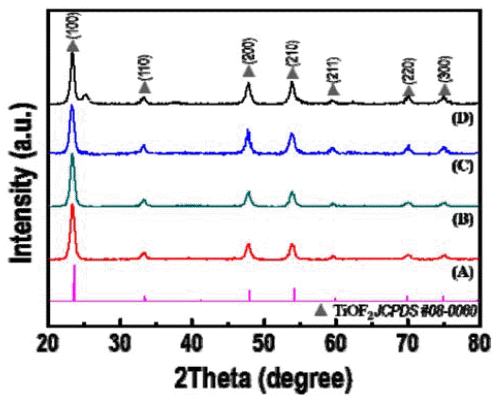
- 506 View
- 1 Download
- 1 Citations
-
 Abstract
Abstract
 PDF
PDF TiOF2, which has remarkable electrochemical and optical properties, is used in various applications such as Li-ion batteries, electrochemical displays, and photocatalysts. In addition, it is possible to utilize the template which is allowed to synthesize fluorine doped TiO2 powders with hollow or faceted structures. However, common synthesis methods of TiOF2 powders have some disadvantages such as the use of expensive and harmful precursors and batchtype processes with a limited production scale. In this study, we report a synthetic route for preparing TiOF2 powders by using an inexpensive and harmless precursor and a continuous ultrasonic spray pyrolysis process under a controlled atmosphere to address the aforementioned problems. The synthesized powder has an average size of 1 μm, a spherical shape, a pure TiOF2 phase, and exhibits a band-gap energy of 3.2 eV.
-
Citations
Citations to this article as recorded by- Photocatalytic activity of rutile TiO2 powders coupled with anatase TiO2 nanoparticles using surfactant
Jong Min Byun, Chun Woong Park, Young In Kim, Young Do Kim
journal of Korean Powder Metallurgy Institute.2018; 25(3): 257. CrossRef
- Photocatalytic activity of rutile TiO2 powders coupled with anatase TiO2 nanoparticles using surfactant
- [Korean]
- Preparation of Ni(OH)2 Hollow Spheres by Solvent Displacement Crystallization Using Micro-Injection Device
- Seiki Kim, Kyungsoo Park, Kwang-Il Jung
- J Korean Powder Metall Inst. 2016;23(4):311-316. Published online August 1, 2016
- DOI: https://doi.org/10.4150/KPMI.2016.23.4.311
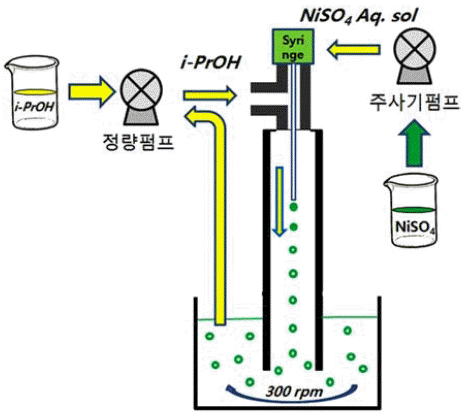
- 848 View
- 9 Download
- 1 Citations
-
 Abstract
Abstract
 PDF
PDF Ni(OH)2 hollow spheres have been prepared by solvent displacement crystallization using a micro-injection device, and the effect of process parameters such as concentration and the relative ratio of the injection speed of the precursor solution, which is an aqueous solution of NiSO4·6H2O, to isopropyl alcohol of displacement solvent have been investigated. The crystal phases after NaOH treatment are in the β-phase for all process parameters. A higher concentration of NiSO4·6H2O aqueous solution is injected by a micro-injection device and bigger Ni(OH)2 hollow spheres with a narrower particle size distribution are formed. The crystallinity and hardness of the as-obtained powder are so poor that hydrothermal treatment of the as-obtained Ni(OH)2 at 120°C for 24 h in distilled water is performed in order to greatly improve the crystallinity. It is thought that a relative ratio of the injection speed of NiSO4·6H2O to that of isopropyl alcohol of at least more than 1 is preferable to synthesize Ni(OH)2 hollow spheres. It is confirmed that this solution- based process is very effective in synthesizing ceramic hollow spheres by simple adjustment of the process parameters such as the concentration and the injection speed.
-
Citations
Citations to this article as recorded by- The Effects of Hexamethylenetetramine Concentration on the Structural and Electrochemical Performances of Ni(OH)2 Powder for Pseudocapacitor Applications
Dong Yeon Kim, Young-Min Jeong, Seong-Ho Baek, Injoon Son
Journal of Korean Powder Metallurgy Institute.2019; 26(3): 231. CrossRef
- The Effects of Hexamethylenetetramine Concentration on the Structural and Electrochemical Performances of Ni(OH)2 Powder for Pseudocapacitor Applications
- [Korean]
- Fabrication of Carbon-coated Tin Nano-powders by Electrical Wire Explosion in Liquid Media and its Electrochemical Properties
- Yoo-Young Kim, Ju-Suck Song, Kwon-Koo Cho
- J Korean Powder Metall Inst. 2016;23(4):317-324. Published online August 1, 2016
- DOI: https://doi.org/10.4150/KPMI.2016.23.4.317
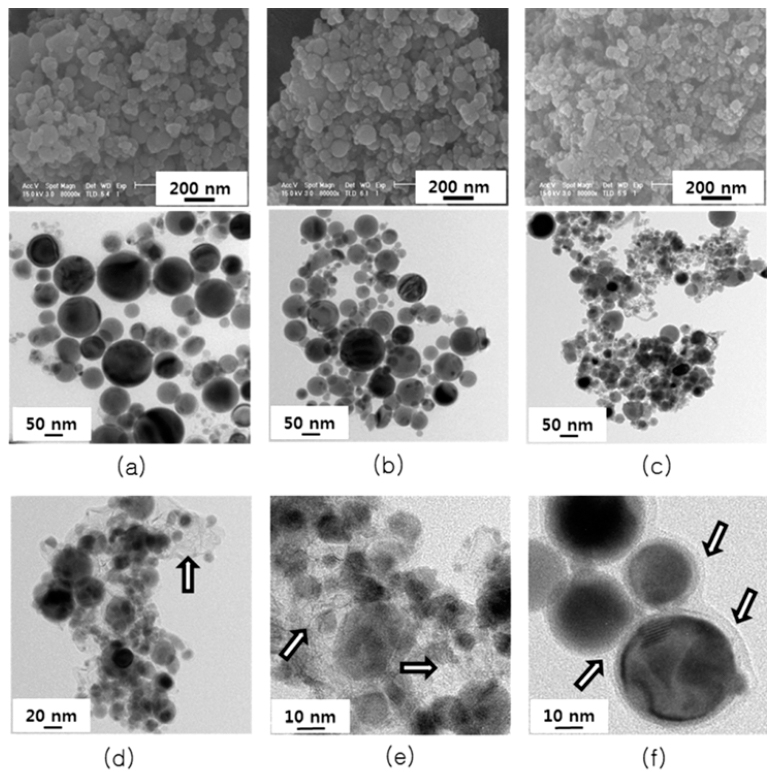
- 716 View
- 3 Download
- 2 Citations
-
 Abstract
Abstract
 PDF
PDF Tin is one of the most promising anode materials for next-generation lithium-ion batteries with a high energy density. However, the commercialization of tin-based anodes is still hindered due to the large volume change (over 260%) upon lithiation/delithiation cycling. To solve the problem, many efforts have been focused on enhancing structural stability of tin particles in electrodes. In this work, we synthesize tin nano-powders with an amorphous carbon layer on the surface and surroundings of the powder by electrical wire explosion in alcohol-based liquid media at room temperature. The morphology and microstructures of the powders are characterized by scanning electron microscopy, Xray diffraction, Raman spectroscopy, and transmission electron microscopy. The electrochemical properties of the powder for use as an anode material for lithium-ion battery are evaluated by cyclic voltammetry and a galvanometric dischargecharge method. It is shown that the carbon-coated tin nano-powders prepared in hexanol media exhibit a high initial charge specific capacity of 902 mAh/g and a high capacity retention of 89% after 50 cycles.
-
Citations
Citations to this article as recorded by- Optimization of carbon coating thickness to prevent crack generation in Sn nanoparticles during charge/discharge process and their electrochemical properties
Ji-Seub Choi, Yeon-Ju Lee, Hoi-Jin Lee, Gyu-Bong Cho, Jai-Won Byeon, Hyo-Jun Ahn, Ki-Won Kim, Jou-Hyeon Ahn, Kwon-Koo Cho
Journal of Alloys and Compounds.2020; 843: 155892. CrossRef - Fabrication of multilayer graphene-encapsulated Sn/SnO2 nanocomposite as an anode material for lithium-ion batteries and its electrochemical properties
Ju-Seok Song, Gyu-Bong Cho, Ki-Won Kim, Hyo-Jun Ahn, Hye-Sung Kim, Jou-Hyeon Ahn, Kwon-Koo Cho
Applied Surface Science.2019; 481: 736. CrossRef
- Optimization of carbon coating thickness to prevent crack generation in Sn nanoparticles during charge/discharge process and their electrochemical properties
- [Korean]
- Status of ITU-T International Standard Development on Rare Metal Recycling
- Mi Hye Lee, Won Jung Choi, Seok-Jun Seo, Bum Sung Kim
- J Korean Powder Metall Inst. 2016;23(4):325-330. Published online August 1, 2016
- DOI: https://doi.org/10.4150/KPMI.2016.23.4.325
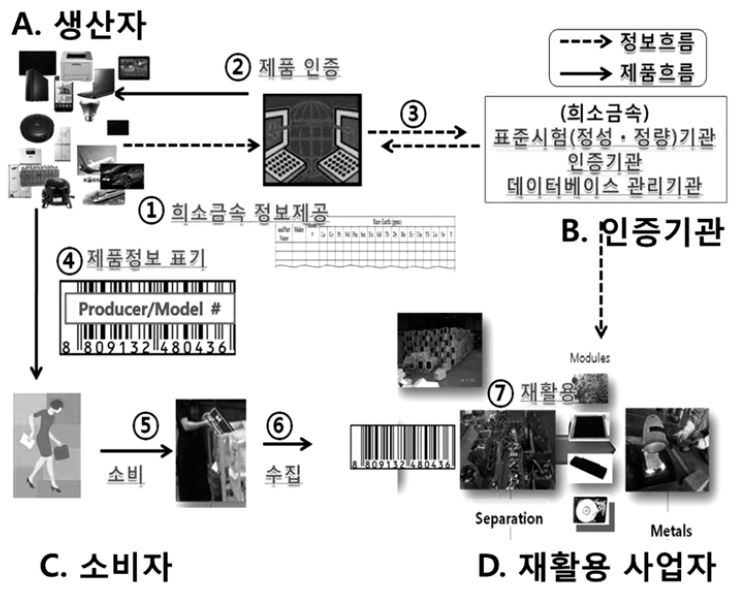
- 843 View
- 1 Download
- 3 Citations
-
 Abstract
Abstract
 PDF
PDF Owing to increasing demand of rare metals present in ICT products, it is necessary to promote the rare metal recycling industry from an environmental viewpoint and to prevent climate change. Despite the fact that information for toxic substances is partly indicated, a legal basis and an international standard indicating usage of rare metals is insufficient. In order to address this issue, a newly created study group of environment and climate change at the ITU (International Telecommunication Union) is doing research to develop methodologies for recycling rare metals from ICT products in an eco-friendly way. Under this group, the Republic of Korea has established two international standards related to rare metals present in ICT products. The first is ‘Release of rare metal information for ICT products (ITU-T L.1100)’ and the other is ‘Quantitative and qualitative analysis methods for rare metals (ITU-T L.1101)’. A new proposal for recommending the provision of rare metal information through a label by manufacturers and consumer/recycling businesses has been approved recently and is supposed to be published later in 2016. Moreover, these recommendations are also being extended to IEC, ISO and other standardization organizations and a strategy to reinforce the ability for domestic standardization is being established in accordance with industrial requirements. This will promote efficient recycling of rare metals from ICT products and will help improve the domestic supply of rare metals.
-
Citations
Citations to this article as recorded by- The State of Affairs of ‘Rare Metal Industry’ in Korea
Jae Hong Shin, Lee Ro Woon, Kyoung Tae Park
Kompleksnoe Ispolʹzovanie Mineralʹnogo syrʹâ/Complex Use of Mineral Resources/Mineraldik Shikisattardy Keshendi Paidalanu.2024; 330(3): 43. CrossRef - Russian Mineral Market Flow and Economic Direction for Securing Stable Resources
Nu Si A Eom, Su Noh, Muhammad Aneeq Haq, Bin Lee, Kyoung Mook Lim, Bum Sung Kim
Journal of Korean Powder Metallurgy Institute.2019; 26(4): 345. CrossRef - Trends and Implications of International Standardization for Rare Earths
Sardar Farhat Abbas, Sang-Hyun lee, Bin Lee, Bum-Sung Kim, Taek-Soo Kim
Journal of Korean Powder Metallurgy Institute.2018; 25(2): 165. CrossRef
- The State of Affairs of ‘Rare Metal Industry’ in Korea
TOP
 KPMI
KPMI




 First
First Prev
Prev


